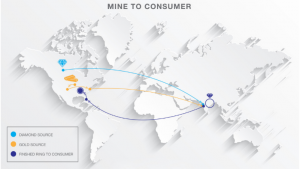
TrustChain is initially tracking six styles of diamond and gold engagement rings on its blockchain network. As the program continues to develop, the trademark of TrustChain jewelry is expected to be accessible to consumers in participating retail stores by the end of 2018.

“This initiative is important for our industry as we seek to raise the collective responsibility and provenance practices to new heights. TrustChain is the first blockchain of its kind within our industry, designed as a solution that marries IBM’s leading blockchain technology with responsible sourcing, verification and governance by third party organizations, led by UL as the administrator,” said Mark Hanna, Richline Group’s Chief Marketing Officer.
The TrustChain Initiative
The Trustchain Initiative uses the IBM Blockchain Platform, delivered via the IBM Cloud. Participants include:
- Asahi Refining (a precious metals refiner)
- Helzberg Diamonds (a U.S. jewelry retailer and subsidiary of Berkshire Hathaway)
- LeachGarner (a precious metals supplier)
- the Richline Group (a global jewelry manufacturer)
- UL (an independent, third party focusing on verification).
“The global scale and complexity of the jewelry market makes it ripe for blockchain to serve as a unifier for all participants to improve trust, transparency and efficiency. It also illustrates the ways in which blockchain can be used to form entirely new business models where all parties win,” said Bridget van Kralingen, Senior Vice President, IBM Industry Platforms and Blockchain. “The collaboration will benefit not only trade partners, but also the individuals who matter most – consumers purchasing gold and diamonds to mark milestone moments in their lives.”
How the TrustChain Initiative will function

The purpose of the Initiative is to track and authenticate diamonds and precious metals through every stage of the supply chain as a piece evolves from original ingredient to finished jewelry. It will provide digital verification, physical product and process verification and third-party oversight.
The collaboration’s goal is to instill trust in the origin and ethical sourcing of jewelry.The mechanism is by bringing together a community of responsible and ethical organizations across a complex and multi-tiered jewelry supply chain.
Built by IBM Services on HyperLedger open source technology, and based on the IBM Blockchain Platform, TrustChain will use distributed ledger technology to:
- establish a shared, immutable record of transactions that take place within a network
- enable permissioned parties to access trusted data in real time.
The impact
By applying the technology to digitize processes, a new form of command and consent is introduced into the flow of information. According to IBM this “empower(s) those in the blockchain network to collaborate and establish a single shared view of information without compromising details, privacy or confidentiality”.
For consumers, TrustChain establishes a trusted product with documented provenance. It brings together quality assurance, social and environmental responsibility and authenticity spanning the jewelry ecosystem on a single digital platform:
- from mining
- to manufacturing
- to wholesale supply
- to retailing.
Enterprise Times: what does this mean
This TrustChain Iniative is not wholly unique, nor an absolute first. Blockchain-provider Everledger has attracted, for example, Brilliant Earth, Gübelin Gem Lab. and the Singapore Diamond Exchange (SDIX).
In contrast to the Everledger initiatives, TrustChain seeks to integrate the supply chain, from raw materials to finished item. This is different. It is also, potentially, a cause for concern. Nowhere in the TrustChain announcement is there mention of additional parties being able (welcome) to join. If this is a ‘closed blockchain supply chain’, might this become a cartel of sorts, or even an opportunity to fix prices?
On the other hand, if TrustChain is open to third parties, it should be consumers who benefit. Who wants to wear jewelry tainted by war diamonds or blood gold or child labour?
NB. The TrustChain Initiative is different from Trustchain Systems, though the objectives are similar.


























[…] high value, low volume environment. Enterprise Times believes there will be many more such examples as luxury goods industries understand the advantages. No doubt other high value manufacturers will […]